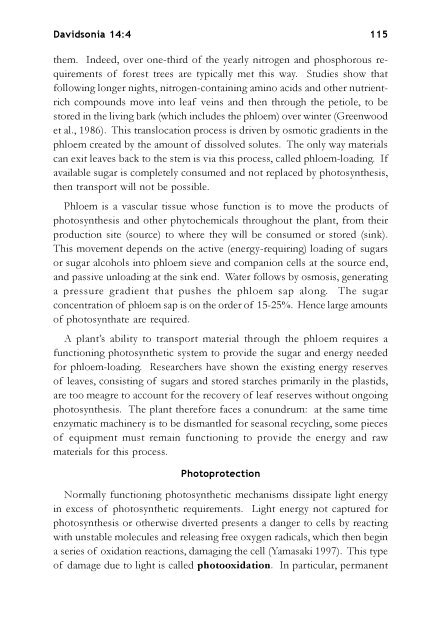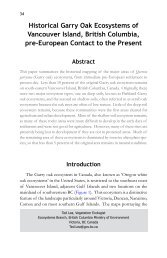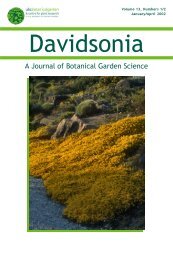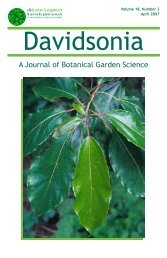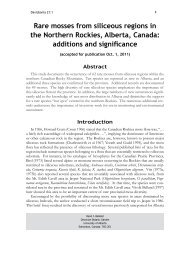pdf wkg Dav.14-14 - Davidsonia
pdf wkg Dav.14-14 - Davidsonia
pdf wkg Dav.14-14 - Davidsonia
You also want an ePaper? Increase the reach of your titles
YUMPU automatically turns print PDFs into web optimized ePapers that Google loves.
<strong>Davidsonia</strong> <strong>14</strong>:4<br />
115<br />
them. Indeed, over one-third of the yearly nitrogen and phosphorous requirements<br />
of forest trees are typically met this way. Studies show that<br />
following longer nights, nitrogen-containing amino acids and other nutrientrich<br />
compounds move into leaf veins and then through the petiole, to be<br />
stored in the living bark (which includes the phloem) over winter (Greenwood<br />
et al., 1986). This translocation process is driven by osmotic gradients in the<br />
phloem created by the amount of dissolved solutes. The only way materials<br />
can exit leaves back to the stem is via this process, called phloem-loading. If<br />
available sugar is completely consumed and not replaced by photosynthesis,<br />
then transport will not be possible.<br />
Phloem is a vascular tissue whose function is to move the products of<br />
photosynthesis and other phytochemicals throughout the plant, from their<br />
production site (source) to where they will be consumed or stored (sink).<br />
This movement depends on the active (energy-requiring) loading of sugars<br />
or sugar alcohols into phloem sieve and companion cells at the source end,<br />
and passive unloading at the sink end. Water follows by osmosis, generating<br />
a pressure gradient that pushes the phloem sap along. The sugar<br />
concentration of phloem sap is on the order of 15-25%. Hence large amounts<br />
of photosynthate are required.<br />
A plant’s ability to transport material through the phloem requires a<br />
functioning photosynthetic system to provide the sugar and energy needed<br />
for phloem-loading. Researchers have shown the existing energy reserves<br />
of leaves, consisting of sugars and stored starches primarily in the plastids,<br />
are too meagre to account for the recovery of leaf reserves without ongoing<br />
photosynthesis. The plant therefore faces a conundrum: at the same time<br />
enzymatic machinery is to be dismantled for seasonal recycling, some pieces<br />
of equipment must remain functioning to provide the energy and raw<br />
materials for this process.<br />
Photoprotection<br />
Normally functioning photosynthetic mechanisms dissipate light energy<br />
in excess of photosynthetic requirements. Light energy not captured for<br />
photosynthesis or otherwise diverted presents a danger to cells by reacting<br />
with unstable molecules and releasing free oxygen radicals, which then begin<br />
a series of oxidation reactions, damaging the cell (Yamasaki 1997). This type<br />
of damage due to light is called photooxidation. In particular, permanent


